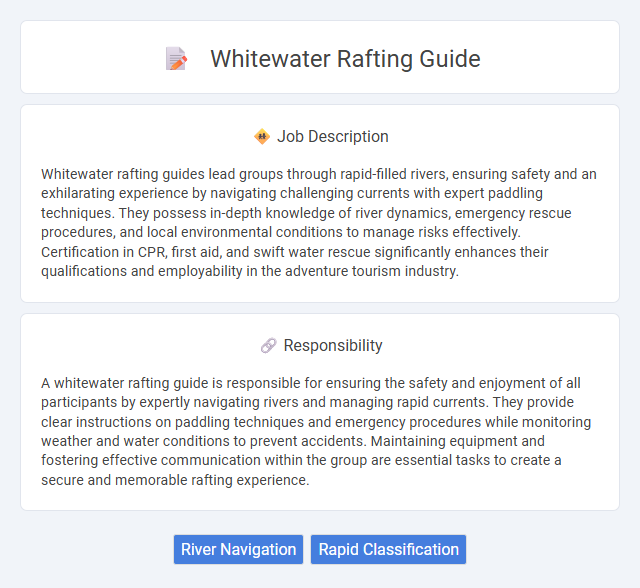
Whitewater rafting guides lead groups through rapid-filled rivers, ensuring safety and an exhilarating experience by navigating challenging currents with expert paddling techniques. They possess in-depth knowledge of river dynamics, emergency rescue procedures, and local environmental conditions to manage risks effectively. Certification in CPR, first aid, and swift water rescue significantly enhances their qualifications and employability in the adventure tourism industry.
Individuals with strong physical fitness and a high level of stamina are likely suitable for a whitewater rafting guide job, as it demands endurance and strength to navigate challenging river conditions safely. Those comfortable with fast-paced, outdoor environments and possessing excellent problem-solving skills probably find this occupation well-suited to their abilities. People with a fear of water or poor swimming skills may have difficulty performing effectively and maintaining safety standards in this role.
Qualification
A Whitewater Rafting Guide must possess comprehensive knowledge of river dynamics, water safety protocols, and emergency rescue techniques, supported by certifications such as Swiftwater Rescue and CPR. Physical fitness, strong leadership skills, and the ability to instruct and motivate groups in challenging outdoor environments are essential qualifications. Experience in navigating Class III to Class V rapids ensures proficiency and enhances guest safety on demanding river expeditions.
Responsibility
A whitewater rafting guide is responsible for ensuring the safety and enjoyment of all participants by expertly navigating rivers and managing rapid currents. They provide clear instructions on paddling techniques and emergency procedures while monitoring weather and water conditions to prevent accidents. Maintaining equipment and fostering effective communication within the group are essential tasks to create a secure and memorable rafting experience.
Benefit
Working as a whitewater rafting guide offers the probability of gaining valuable outdoor leadership experience and enhancing teamwork skills. There may be benefits including physical fitness improvement and the opportunity to connect with nature on a regular basis. The role likely provides seasonal employment with potential for tips and access to discounted or free equipment use.
Challenge
Working as a whitewater rafting guide likely involves facing unpredictable river conditions that test both physical endurance and quick decision-making skills. The challenge probably lies in ensuring safety while navigating turbulent waters, requiring constant attention and adaptability. Guides may often experience high-pressure situations that demand effective communication and leadership under stress.
Career Advancement
A Whitewater rafting guide role offers valuable hands-on experience in outdoor leadership, safety management, and customer service, essential for career growth in adventure tourism. Advancing in this field often involves obtaining certifications such as Swiftwater Rescue and Wilderness First Responder, which enhance credibility and open opportunities for higher-level positions like trip coordinator or rafting operations manager. Building a strong reputation through excellent guiding skills and networking within the rafting community can lead to roles in training new guides or managing guide teams.
Key Terms
River Navigation
Whitewater rafting guides specialize in expert river navigation, using their knowledge of river currents, eddies, and rapids to ensure safe and thrilling trips. They assess water conditions in real-time, directing rafters through complex sections like Class III or IV rapids while avoiding hazards. Mastery of river topography and swift decision-making are crucial for a successful whitewater rafting experience.
Rapid Classification
Whitewater rafting guides must possess in-depth knowledge of rapid classification systems such as the International Scale of River Difficulty, which ranges from Class I (easy) to Class VI (extreme). Their expertise in identifying and navigating Class III to Class V rapids ensures client safety while delivering thrilling experiences. Mastery of rapid classifications enables guides to assess river conditions accurately and adapt strategies for varying water flows and obstacles.
 kuljobs.com
kuljobs.com